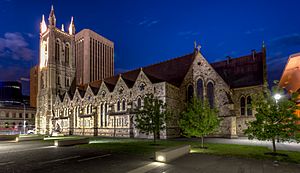St Francis Xavier's Cathedral, Adelaide facts for kids
Quick facts for kids St Francis Xavier's Cathedral |
|
|---|---|

The cathedral at night
|
|
| 34°55′44″S 138°36′05″E / 34.9290°S 138.6014°E | |
| Location | Adelaide, South Australia |
| Country | Australia |
| Denomination | Catholic Church |
| History | |
| Status | Cathedral |
| Consecrated | 11 July 1858 (Stage 1) 18 April 1926 (Stage 2) 11 July 1996 (Stage 3) |
| Architecture | |
| Architect(s) | Richard Lambeth, Charles Hansom, Peter Paul Pugin, Lynton Jury |
| Style | Gothic Revival |
| Groundbreaking | 17 March 1856 |
| Completed | 11 July 1996 |
| Specifications | |
| Height | 36 metres (118 ft) |
| Bells | 14 |
| Administration | |
| Archdiocese | Archdiocese of Adelaide |
St Francis Xavier's Cathedral is a beautiful and historic Catholic church in Adelaide, South Australia. It's a special kind of church called a Cathedral, which is the main church for a bishop. The building looks like old churches from the Gothic Revival style, especially the Early English style.
Work on the cathedral began in 1856. The first part was finished and opened in 1858. The tall tower was started in 1887 but took a long time to build. It was finally completed in 1996. The tower stands about 36 metres (118 ft) high. The whole building is about 56.5 metres (185 ft) long and 29.5 metres (97 ft) wide.
Contents
History of the Cathedral
Early Days and First Buildings
In 1838, just two years after South Australia was founded, people started organizing Catholic meetings. The very first Mass, which is a special church service, happened in a house in 1840. Later, in 1845, a Catholic primary school was built. This school became the main place for Catholics to gather.
In 1851, plans were made for a cathedral, and a special "foundation stone" was laid. This stone marks the beginning of a new building. However, many people left Adelaide for the gold rush in Victoria. The architect also left, and the community faced tough economic times.
Building and Expanding the Cathedral
The current cathedral's foundation stone was laid on March 17, 1856. This was done by Father Michael Ryan. The first part of the cathedral was officially opened on July 11, 1858. Soon after, in January 1859, they started building an extension. This included the sanctuary, side chapel, lady chapel, and sacristy. This first extension was finished in November 1860.
As more people moved to Adelaide, the church needed to be bigger. In November 1886, Bishop Reynolds laid another foundation stone. This was for an extension on the eastern side to fit 200 more people. New vestries and confessionals were also added. These parts were completed in August 1887. In 1904, electric lights were installed in the cathedral.
The Tower and Later Additions
The cornerstone for the bell tower was placed in 1887. But the lower part of the tower was only built much later, between 1923 and 1926. During this time, the western aisle of the cathedral was also made longer. The expanded building was opened in April 1926 by Archbishop Robert Spence.
On March 8, 1931, Archbishop Spence dedicated the octagonal pulpit. A pulpit is a raised platform where sermons are given. This one was designed by Herbert Jory and had beautiful carvings. It was built to remember Catholic soldiers who died in World War I. It is considered a very important piece of church furniture.
The bell tower was finally completed in 1996 by architect Lynton Jury. This was 109 years after it was first started! The main bell, called the Murphy Bell, dates back to 1867. It is surrounded by thirteen other bells. These bells are used for "change ringing," a special way of ringing bells. Seven of these bells came from St Mary's Cathedral, Sydney and date from 1881.
The cathedral was also damaged by an earthquake in Adelaide in 1954.
Special Features of the Cathedral
Statues and Altars
At the north-western side of the cathedral, there is a statue of St John the Baptist. This statue was carved in Tuscany, Italy, in 1925. It shows a picture of Jesus being baptized.
The lady chapel altar is located on the south-west side. It is made from beautiful Carrara marble. It has panels that look like lapis lazuli, a blue stone. This altar was dedicated in 1954. You can also see bronze statues of Joseph and Jesus. They show the story of their flight into Egypt.
At the front of the cathedral, on the southern end, are special windows called lancet windows. They show pictures of St Patrick and St Lawrence. There are also pictures showing parts of the life of Mary, Jesus's mother, and Jesus himself. On the eastern side, there is a statue of St Patrick, who is the special saint for the Archdiocese of Adelaide. You can see Celtic symbols around him.
Organs and Bells
The cathedral has had three different organs over its history. The first one was installed in 1869. It was replaced in 1926 by a new organ. This organ was then rebuilt in 1954.
The bells in the tower are rung by members of The Australian and New Zealand Association of Bellringers. They practice a special art of ringing the bells in different patterns.
Services and Activities
The cathedral is open every day from early morning until evening. Mass is celebrated three times a day. The cathedral also has a choir that sings during services.
Gallery
-
View from Victoria Square
-
Statue of Saint Mary MacKillop
See also
 In Spanish: Catedral de San Francisco Javier (Adelaida) para niños
In Spanish: Catedral de San Francisco Javier (Adelaida) para niños
- Fennescey House









